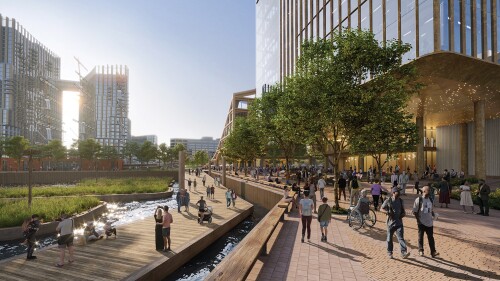Both net zero carbon and social equity have taken on increasing momentum within real estate environmental, social, and governance (ESG) goals in recent years. Many companies have intensified their commitments along both lines, but real estate professionals often consider environmental and social initiatives as distinct pursuits under the ESG and diversity, equity & inclusion umbrellas.
Although the industry is just beginning to understand how to fully integrate these two spheres, Net Zero for All: A Just Transition for Real Estate, a recent report from the Urban Land Institute, makes the case that embedding social impact within companies’ net zero strategy creates stronger ESG and development outcomes for everyone. (Disclosure: the author of this article is also the lead author of the report.)
What is a just transition, and why does it matter?
Communities that have been marginalized along various lines of identity (whether by race, national origin, class, gender, sexual orientation, ability, age, or any other dimension) have long experienced the direct and indirect effects of the climate crisis first and worst. For example:
- Native American households spend 45 percent more of their income on energy costs than white households, while Black households spend 43 percent more and Hispanic households spend 20 percent more. High energy burdens are associated with outcomes such as greater risk of respiratory disease, increased stress, and reduced economic mobility.
- Black and Hispanic households are roughly twice as likely as white households to reside in moderately or severely inadequate housing.
- Black households making between $50,000 and $60,000 a year experience the same level of pollution burden as white households making $10,000 or less.
Simultaneously, the transition to net zero will usher in tremendous potential for transformation within economic, environmental, and social realms. These shifts have the potential to generate significant wealth, improve health, and bolster climate resilience.
If these changes are managed carefully, decarbonization can help dismantle social inequalities by prioritizing the needs, experiences, and opportunities of marginalized households. The goal is to ensure everyone benefits from efficient, cost-effective, and healthy buildings and energy systems, access to economic growth, and a regenerative economy.
This is what is meant by a “just transition,” the framework of which was created by two organizations—the Climate Justice Alliance and Movement Generation, based on decades of organizing in the fields of environmental justice, labor, and more.
What is the business case for a just transition?
The business case for integrating social equity into net zero real estate has become clearer over time, and market and policy drivers suggest the industry can achieve material financial and nonfinancial returns from an investment in an equitable transition. Sources of returns can include:
- More stable markets. Investing for social impact can build value over time by unearthing unexpressed human and social capital, demonstrating potential untapped markets, and recirculating dollars within communities through local businesses and organizations. These investments build on each other, improving quality of life while paving the way for further investments down the line.
- More valuable real estate. Net zero buildings often see a green premium, carrying lower operating costs, higher net operating income (NOI), qualifying for better finance terms, securing higher sales and rental income, reducing turnover and boosting occupancy rates. Mechanisms to share these increases in value with occupants and communities, such as cooperative ownership models, helps ensure net zero supports economic growth for all.
- Investor demand, access to capital, and brand benefits. Investors and end users increasingly expect real estate to act on a variety of ESG issues. Firms acting authentically and demonstrably on a just transition will preserve their access to capital by remaining competitive for investment. For example, nearly 70 percent of investors and 100 percent of investment managers surveyed for ULI’s Social Impact: Investing with Purpose to Protect and Enhance Returns report expected their social value and social impact activity to increase over the next three years.
As Joe Ritchie, managing director of business development and head of diversity and inclusion at Tishman Speyer, notes: “We raise capital from third parties for our deals. Those LPs are more and more interested in diversity and racial equity and seeing that manifested in the people with whom they do business—both in their employee makeup and their business practices. As that grows, it will be more of an imperative for all of us to think about it.”
Other critical sources of returns can include increased community and local support for development, which reduces development costs and timelines; more resilient supply chains through diversification; reduced workforce shortages for key net zero roles, such as electricians or other skilled trades; and staying on top of local or national policy with sustainability and equity elements, such as next-generation building performance standards or city climate equity plans (such as Austin’s or Minneapolis’s).
How can real estate accelerate a just transition?
The real estate industry’s influence over the built environment and on wealth and wellbeing situates it in a unique position to address the intersecting challenges of climate and social equity.
As Derrick Tillman, CEO of Bridging the Gap Development, puts it:
“Traditionally, when major advancements are happening in technology, clean energy, or life sciences, Black and low-income communities and people have been left out of the resulting economic upward mobility and opportunity for wealth creation. That has to be central this time.”
To successfully embed social equity into real estate’s net zero work, companies can apply many of the lessons learned in the field of equitable development to decarbonization within every aspect of ULI’s Real Estate Journey to Net Zero, shown below.
When working on net zero developments, activities that could fall under the ‘just transition’ concept could include:
- Diversifying internal project staff and development partners
- Diversifying supply chains, such as vendors and contractors
- Deep community engagement to ensure projects meet community needs
- Hosting community-owned renewable energy or community solar
- Developing or retrofitting for affordable, healthy, resilient, net zero homes and businesses
- Equitable wealth building and investments in net zero-related projects
- Workforce development for marginalized communities in sustainable technologies and industries
Real estate leaders are already turning to these strategies to further their equitable decarbonization goals. Examples of how companies are achieving equity at every stage of the Journey, such as Bridging the Gap Development, THRIVE Collaborative, or L+M Development partners, can be found in the full report.
Taking a comprehensive approach
The just transition framework for net zero in real estate is an excellent way to address the variety of environmental and social issues many marginalized communities face, in addition to the need for decarbonization.
Environmental justice advocates have long pushed for many of these challenges to be prioritized by the private sector, and resources such as the Zero Cities Project’s Equity Assessment Tool and the Urban Sustainability Directors Network (USDN) and partners’ Equity and Buildings: A Practical Framework for Local Government Decision Makers lay them out in detail. For example, real estate wields powerful tools to:
- Reduce energy burdens for BIPOC and low-income households by developing more community solar or otherwise improving access to renewable energy and energy efficiency retrofit programs
- Improve economic inclusion of marginalized communities by diversifying procurement policies, boosting workforce training, or leasing space in net zero buildings to local, women- or BIPOC-owned businesses and organizations
- Reduce gentrification and displacement by ensuring overall tenant costs remain lower in net zero buildings, through resulting low- or zero-cost energy bills and protection from utility rate increases, and partnering with experienced providers to develop affordable net zero housing
- Address low housing quality and health risks by pursuing a combination of net zero and healthy building strategies, such as induction stoves to improve indoor air quality, or retrofits that bring buildings up to code before embarking on emissions reductions
Other challenges for BIPOC and low-income communities that can be resolved through a just transition include environmental pollution and air quality, which can be mitigated through healthy buildings and electrification; urban heat islands and grid strain made worse through waste heat from energy-intensive appliances and vehicles; and risks from climate hazards such as flooding or wildfires that can be reduced by low-carbon materials, construction practices, and distributed energy.
Who can real estate look to for guidance going forward?
Real estate has enormous opportunities ahead for resolving the dual climate and social crises of the moment. Understanding the process can be difficult, but fortunately, community-based organizations have long been leaders in the just transition space, and have created resources to guide the industry.
Organizations such as the Greenlining Institute, the Emerald Cities Collaborative, the Climate Justice Alliance, Movement Generation, the Initiative for Energy Justice, and many more have multiple tools the real estate industry can turn to. By following the thought leadership of those most impacted by climate and environmental issues, real estate can right current and historical inequities and fulfill its potential as a driver for positive social impact.







